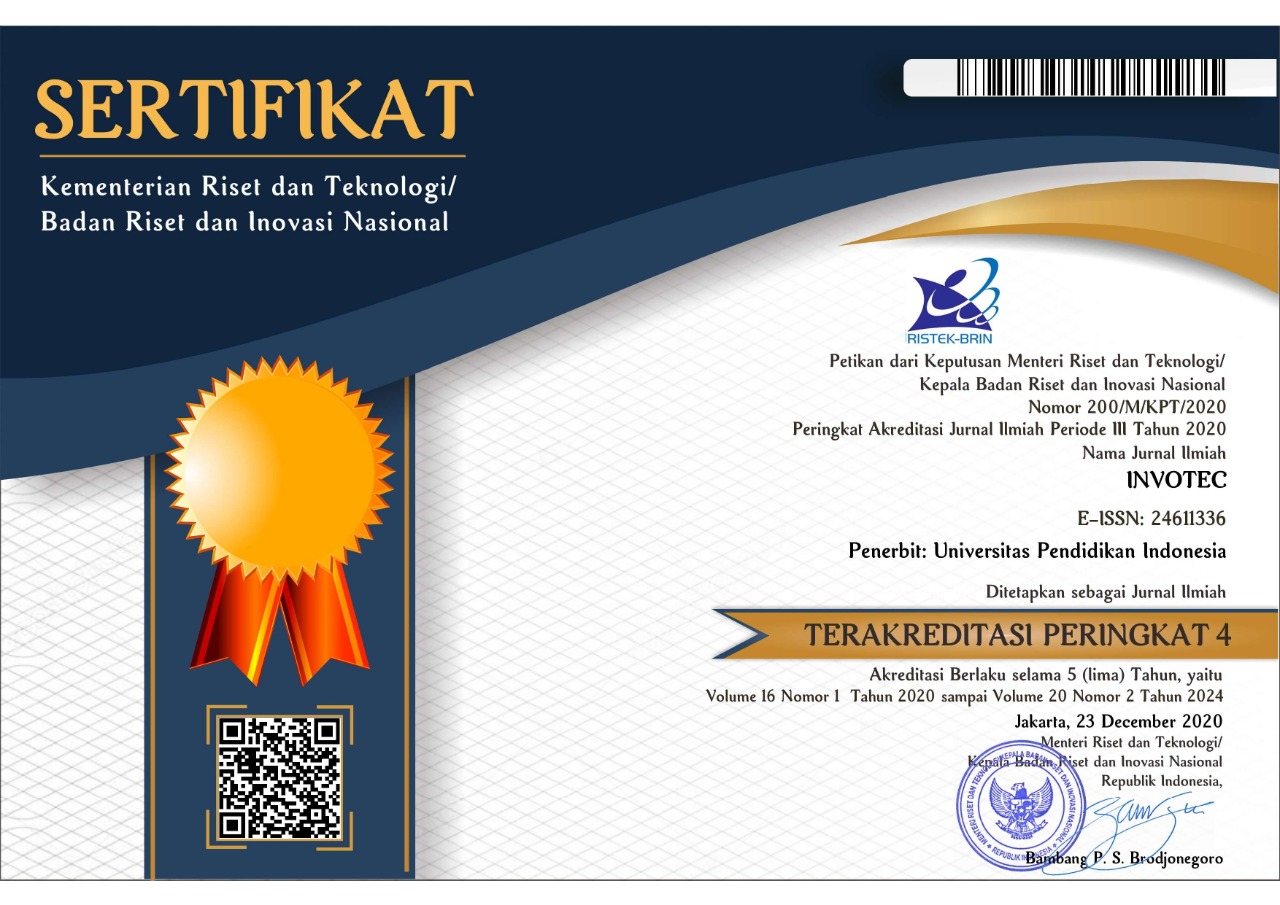Workplace Adaptation for Vocational Schools Graduates
Abstract
Keywords
Full Text:
PDFReferences
Ashford, S. J. (1988). Individual strategies for coping with stress during organizational transitions. The Journal of Applied Behavioral Science, 24(1), 19-36.
Chung-Yan, G. A. (2005). Adapting to the work environment: An integrative model of adaptive skills, person-environment fit and work stress.
Costa Jr, P. T., and McCrae, R. R. (2008). The Revised NEO Personality Inventory (NEO-PI-R). New York: Sage Publications, Inc.
Council of Chief State School Officers (CCSSO, (2020). Opportunities and Options: Making Career Preparation Work for Students. Washington, DC: Council of Chief State School Officers.
Darling-Hammond, L., Flook, L., Cook-Harvey, C., Barron, B., and Osher, D. (2020). Implications for the educational practice of the science of learning and development. Applied Developmental Science, 24(2), 97-140.
Fadel, K. J. (2012). User adaptation and infusion of information systems. Journal of Computer Information Systems, 52(3), 1-10.
Feldman, D. C. (1989). “Socialization, resocialization, and training,” In I. L. Goldstein and Associates, Training and development in organizations (pp 376-416). San Francisco, CA: Jossey-Bass, Inc.
Filmer, D., and Fox, L. (2014). Africa Youth Employment in sub-Saharan Africa. Africa Development Series. Washington, DC: World Bank.
Fleishman, J. A. (1992). Fleishman-job analysis survey (F-JAS). Palo Alto, CA: Consulting Psychologists Press.
Frolenoka, B., and Dukule, O. (2017). Personnel adaptation in the workplace, the quality of working life and subjective well-being. Information technologies, management and society, 10(1), 7-12.
Ghosh, R., Reio Jr, T. G., and Bang, H. (2013). Reducing turnover intent: Supervisor and co-worker incivility and socialization-related learning. Human Resource Development International, 16(2), 169-185.
Greenlaw, J. S. (1972). The use of sawdust piles by nesting Bank Swallows. The Wilson Bulletin, 84(4), 494-496.
Gropello, E., Tan, H., and Tandon, P. (2010). Skills for the Labor Market in the Philippines. Washington, DC: World Bank.
Hasanefendic, S., Heitor, M., and Horta, H. (2016). Training students for new jobs: The role of technical and vocational higher education and implications for science policy in Portugal. Technological Forecasting and Social Change, 113, 328-340.
Hlaďo, P., Lazarová, B., and Hloušková, L. (2019). Career adaptability of vocational education and training graduates in the period of prospective school-to-work transition. Studia paedagogica, 24(2), 59-83.
Holahan, C. J., and Moos, R. H. (1987). Personal and contextual determinants of coping strategies. Journal of personality and social psychology, 52(5), 946.
Holton, E. F. (1992). Holton adaptation to work model: A conceptual model of organizational entry. Unpublished manuscript.
Hough, L. M. (1992). The'Big Five'personality variables--construct confusion: Description versus prediction. Human performance, 5(1-2), 139-155.
Jablin, F. M. (1984). Assimilating new members into organizations. Annals of the International Communication Association, 8(1), 594-627.
Judge, T. A., Thoresen, C. J., Pucik, V., and Welbourne, T. M. (1999). Managerial coping with organizational change: A dispositional perspective. Journal of applied psychology, 84(1), 107.
Kobasa, S. C. (1979). Stressful life events, personality, and health: an inquiry into hardiness. Journal of personality and social psychology, 37(1), 1.
Kunasegaran, M., Ismail, M., Rasdi, R. M., Ismail, I. A., and Ramayah, T. (2016). Talent development environment and workplace adaptation. European Journal of Training and Development.
Lankard, B. A. (1990). Employability--The Fifth Basic Skill. ERIC Digest No. 104.
Laterite, (2019). Preparing Youth for the Transition to Work. www.laterite.com
Ling, T. J., and O'Brien, K. M. (2013). Connecting the forgotten half: The school-to-work transition of noncollege-bound youth. Journal of career development, 40(4), 347-367.
Marlowe, H. A. (1986). Social intelligence: Evidence for multidimensionality and construct independence. Journal of educational psychology, 78(1), 52.
Morton, S. T. (1993). Socialization-related learning, job satisfaction, and commitment for new employees in a federal agency. Doctoral dissertation, Virginia Tech.
Moss, B. (1973). The influence of environmental factors on the distribution of freshwater algae: an experimental study: II. The role of pH and the carbon dioxide-bicarbonate system. The Journal of Ecology, 157-177.
Nambiar, D., Karki, S., Rahardiani, D., Putri, M., and Singh, K. (2019). Study on skills for the future in Indonesia. Oxford Policy Management.
OECD, 2018. Approaches to anticipating skills for the future of work. Report prepared by the ILO and OECD for the G20 Employment Working Group. Geneva, Switzerland.
Overtoom, C. (2000). Employability Skills: An Update. ERIC Digest No. 220.
Parjono, P. (2016). Pengaruh Infrastruktur Guru, Bisnis dan Dukungan Lingkungan Industri Pada Kemampuan Adaptasi Kerja Pada Kemampuan Bekerja Siswa Smk Di Surabaya. Eduka: Jurnal Pendidikan, Hukum, dan Bisnis, 1(1).
Park, S., Kim, E. J., Yoo, S., and Song, J. H. (2018). Validation of the workplace adaptation questionnaire (WAQ) in Korea: Focusing on learning in the workplace. Performance Improvement Quarterly, 31(1), 83-102.
Peterson, N. G., Anderson, L. E., Crafts, J. L., Smith, D. A., and Motowidlo, S. J. (1999). Expanding the Concept of Quality in Personnel. American Institutes for Research Washington Dc.
Pulakos, E. D., Dorsey, D. W., and White, S. S. (2006). Adaptability in the workplace: Selecting an adaptive workforce. In Understanding adaptability: A prerequisite for effective performance within complex environments. Emerald Group Publishing Limited.
Reio Jr, T. G. (1997). Effects of curiosity on socialization-related learning and job performance in adults. Doctoral dissertation, Virginia Tech.
Reio Jr, T. G., and Sutton, F. C. (2006). Employer assessment of work‐related competencies and workplace adaptation. Human Resource Development Quarterly, 17(3), 305-324.
Reio Jr, T. G., and Wiswell, A. (2000). Field investigation of the relationship among adult curiosity, workplace learning, and job performance. Human resource development quarterly, 11(1), 5-30.
Robinson, J. P. (2000). What are employability skills. The workplace, 1(3), 1-3.
Schneider, R. J. (1992). An individual-differences approach to understanding and predicting social competence. Doctoral dissertation, University of Minnesota.
Scoones, I. (2009). Livelihoods perspectives and rural development. The journal of peasant studies, 36(1), 171-196.
Teilegen, A. (2019). Structures of mood and personality and their relevance to assessing anxiety, with an emphasis on self-report. In Anxiety and the anxiety disorders (pp. 681-706). Routledge.
Torunoğlu, H., and Gençtanırım, D. (2015). The perceptions of school counselors about the counseling and guidance programs of vocational high schools. Procedia-Social and Behavioral Sciences, 174, 368-376.
UNESCO, (2012). “Youth and Skills: Putting education to work,” Education for All Global Monitoring Report. Retrieved from http://unesdoc.unesco.org/images/0021/002180/218003e.pdf
Wagner, R. K. (1986). “The search for intraterrestrial intelligence,” In: R. J. Sternberg and Wagner, R. K. (1986). Practical intelligence: Nature and origins of competence in the everyday world. Cambridge: Cambridge University
Wang, M. O., Zhan, Y., McCune, E., and Truxillo, D. (2011). Understanding Newcomers’adaptability and Work‐Related Outcomes: Testing the Mediating Roles of Perceived P–E Fit Variables. Personnel psychology, 64(1), 163-189.
World Bank, (2011). “Strengthening Skills and Employability in Peru,” Retrieved from http://documents.worldbank.org/curated/en/732801468293405763/pdf/616990ESW0whit0ficial0Use0Only00090.pdf
DOI: https://doi.org/10.17509/invotec.v17i2.34398
Refbacks
- There are currently no refbacks.
Copyright (c) 2021 INVOTEC

This work is licensed under a Creative Commons Attribution-ShareAlike 4.0 International License.
This journal provides immediate open access to its content on the principle that making research freely available to the public supports a greater global exchange of knowledge.

This work is licensed under a Lisensi Creative Commons Atribusi-BerbagiSerupa 4.0 Internasional.




